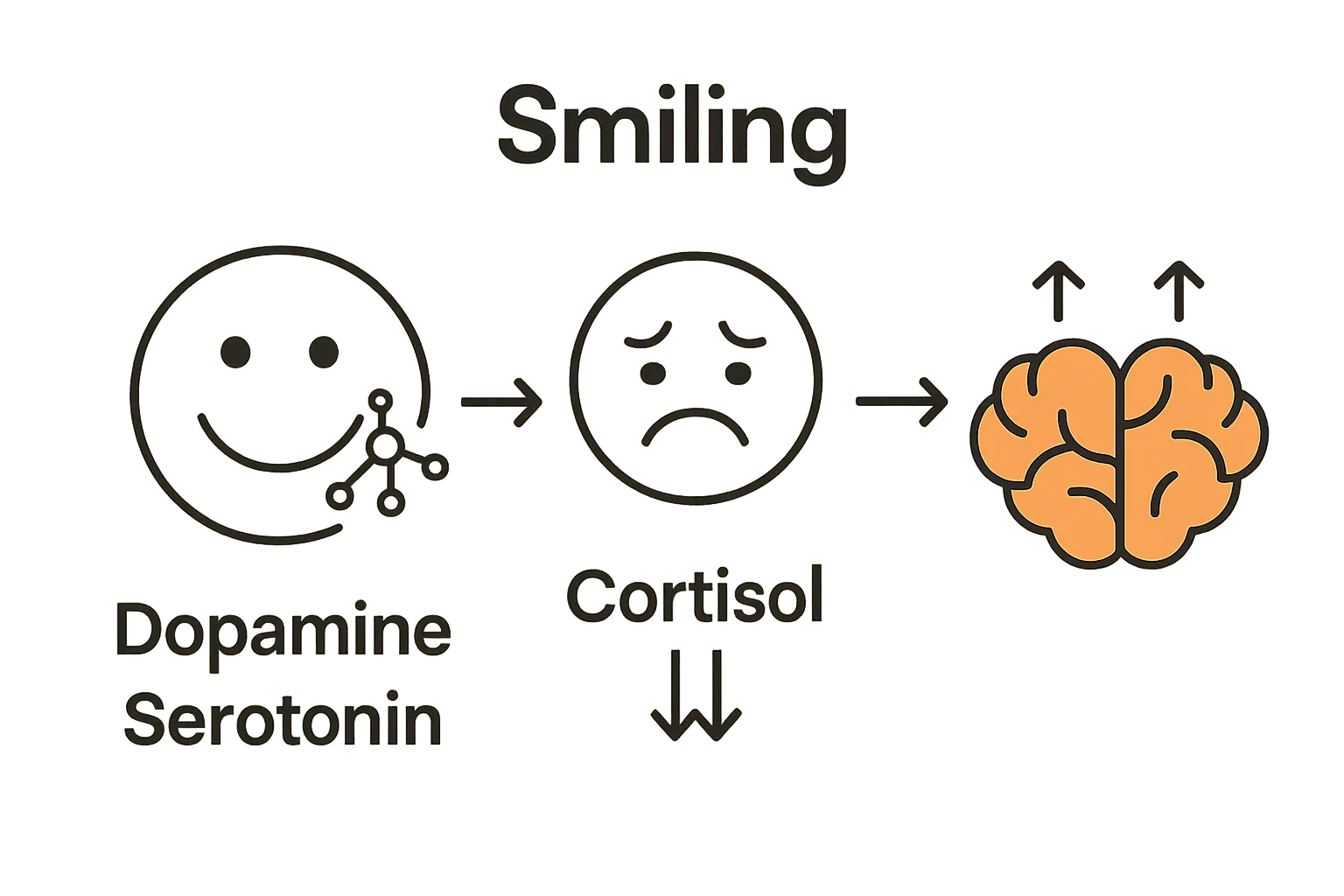Understanding the Connection Between Smiling and Mental Health
October 7, 2025
Understanding the Connection Between Smiling and Mental Health
Smiling might seem like just a way to show you are happy, but it does much more than light up your face. Turns out, a simple smile can actually trigger real changes inside your brain and body. Neuroscientists have found that smiling lowers stress hormones and immediately releases feel-good chemicals like dopamine and serotonin. But what really grabs attention is this: even forcing a smile when you are feeling low can start to lift your mood. This surprising mind-body feedback means that the act of smiling can become a genuine tool for feeling better, no matter where you start.
Table of Contents
- What Is The Connection Between Smiling And Mental Health?
- Why Smiling Matters For Emotional Well-Being
- How Smiling Influences Our Brain And Body
- The Role Of Smiling In Social Interactions And Relationships
Quick Summary
| Takeaway | Explanation |
|---|---|
| Smiling boosts mental health | Smiling triggers neurochemical responses that enhance mood and emotional regulation, leading to improved mental well-being. |
| Smiling interrupts negative emotions | Deliberate smiling can change emotional states, helping individuals counter negative feelings and foster positivity. |
| Smiling enhances social interactions | A smile facilitates trust and emotional connections, making social exchanges more positive and effective in building relationships. |
| Smiling is a health intervention | Physically, smiling can lower stress hormones and improve health indicators like blood pressure and immunity through neurochemical processes. |
| Smiling promotes emotional resilience | Engaging in smiling as a practice strengthens psychological resilience, enabling better stress management and emotional balance. |
What is the Connection Between Smiling and Mental Health?
Smiling is far more than a simple facial expression. It represents a powerful neurological and physiological response that profoundly impacts our mental well-being. Understanding the intricate connection between smiling and mental health reveals how this seemingly simple act can significantly influence our psychological state and emotional resilience.
The Neurochemical Magic of Smiling
When you smile, your brain triggers a complex cascade of neurochemical reactions that directly influence mood and emotional regulation.
VIDEO:video_content] [Neuroscience research from the University of California demonstrates that smiling activates neural messaging pathways that reduce stress hormones like cortisol while simultaneously releasing powerful neurotransmitters such as dopamine and serotonin.
These neurotransmitters play critical roles in emotional regulation:
- Dopamine generates feelings of pleasure and reward
- Serotonin stabilizes mood and promotes emotional balance
- Endorphins act as natural pain relievers and mood elevators
This neurochemical response means that smiling can essentially “trick” your brain into feeling more positive, even when you might not initially feel happy.
Psychological Resilience Through Facial Expression
Beyond biochemical changes, smiling represents a form of psychological intervention. Psychological research published in Psychological Science suggests that the physical act of smiling can actually modify emotional experiences. By deliberately engaging facial muscles associated with smiling, individuals can potentially interrupt negative emotional patterns and promote more adaptive psychological responses.
To clarify the different neurochemical and psychological processes triggered by smiling, the following table summarizes the core mechanisms and their effects on mental health.
| Mechanism | Description | Effect on Mental Health |
|---|---|---|
| Dopamine Release | Neurotransmitter triggered by smiling; generates pleasure and reward | Elevates mood and motivation |
| Serotonin Release | Neurotransmitter released when smiling; stabilizes mood | Promotes emotional balance |
| Endorphin Release | Natural pain-relieving chemicals produced during smiling | Reduces stress and increases positivity |
| Reduction in Cortisol | Stress hormone levels drop as a result of smiling | Lowers anxiety and stress |
| Facial Feedback Hypothesis | Emotional experience is influenced by engaging specific facial muscles (smiling) | Interrupts negative emotions, boosts mood |
| Social Signaling | Smiling communicates openness and safety during social interactions | Builds trust and emotional connection |
This phenomenon demonstrates how our physical expressions can influence our internal emotional landscape. A deliberate smile during challenging moments can serve as a powerful tool for emotional regulation, helping individuals navigate stress and maintain psychological equilibrium.
Understanding the profound connection between smiling and mental health reveals that this simple facial expression is far more than a social signal. It is a sophisticated neurological mechanism capable of transforming our emotional experiences, reducing stress, and promoting psychological well-being.
Why Smiling Matters for Emotional Well-Being
Smiling is not just a reflexive social response but a fundamental mechanism for emotional regulation and psychological health. Understanding its deeper significance reveals how this simple facial expression can serve as a powerful tool for managing mental and emotional states.
Social and Emotional Connection Dynamics
Research from the American Psychological Association reveals that smiling creates significant interpersonal and intrapersonal benefits beyond momentary happiness. When individuals smile, they activate complex social signaling mechanisms that generate positive emotional responses both within themselves and among others.
Key psychological benefits of smiling include:
- Enhancing social bonding and interpersonal trust
- Reducing perceived stress and emotional tension
- Facilitating more positive social interactions
These benefits demonstrate that smiling functions as a sophisticated communication tool that transcends simple facial mechanics, serving crucial emotional and social regulatory purposes.
Neurological Impact on Emotional Resilience
Smiling represents more than a passive emotional response. It is an active intervention strategy for emotional management. By intentionally engaging smile-related facial muscles, individuals can effectively interrupt negative emotional cycles and promote psychological flexibility.
The neurological mechanism underlying this process involves direct stimulation of neural pathways associated with positive emotional states. When a person smiles, even without feeling inherently positive, the brain receives signals that can gradually shift emotional perception. This demonstrates the profound interconnection between physical expression and psychological experience.
By recognizing smiling as a deliberate emotional regulation technique, individuals can harness this natural mechanism to cultivate greater psychological resilience, manage stress more effectively, and maintain a more balanced emotional landscape.
How Smiling Influences Our Brain and Body
Smiling is a powerful physiological mechanism that transforms our neurological and physical state, creating intricate connections between emotional expression and bodily responses. This complex interaction reveals how a simple facial movement can trigger profound changes in our internal systems.
Neurochemical Cascade of Smiling
Neuroscience research from the National Institutes of Health demonstrates that smiling initiates a remarkable neurochemical cascade that profoundly impacts both brain function and physical health. When we smile, our brain releases a sophisticated combination of neurotransmitters and hormones that directly influence our physiological and psychological state.
Key neurochemical responses include:
- Reduction of stress hormones like cortisol
- Increased production of dopamine and serotonin
- Activation of neural reward pathways
These neurochemical changes occur almost instantaneously, illustrating the remarkable speed and complexity of our body’s emotional processing systems.

Physical Health Implications
Beyond neurochemical changes, smiling generates measurable physical health benefits. The act of smiling can lower blood pressure, reduce heart rate, and boost immune system functionality. This demonstrates that emotional expressions are not isolated psychological events but integrated biological processes that influence our overall physiological well-being.
The connection between smiling and physical health underscores the intricate relationship between emotional expression and bodily systems. By understanding these connections, individuals can recognize smiling as more than a social gesture—it is a powerful tool for maintaining holistic health and promoting physiological balance.
This table outlines the key social and physical benefits of smiling as discussed throughout the article, helping to visualize the holistic impacts on both emotional and physical well-being.
| Benefit Category | Specific Benefit | Description |
|---|---|---|
| Social | Enhances social bonding | Facilitates trust and positive connections in interactions |
| Social | Reduces social tension | Makes others feel at ease and decreases interpersonal stress |
| Social | Signals approachability | Indicates openness and willingness to communicate |
| Emotional | Promotes emotional resilience | Helps manage stress and regulate mood |
| Emotional | Interrupts negative cycles | Deliberate smiling can disrupt negative emotional states |
| Physical | Lowers blood pressure | Physically relaxes the body and improves cardiovascular health |
| Physical | Boosts immune function | Strengthens the immune system via neurochemical responses |
| Physical | Reduces heart rate | Induces physiological calm through emotional expression |
The sophisticated interplay between smiling, brain function, and bodily responses reveals the extraordinary complexity of human emotional and physical mechanisms, highlighting how a simple facial expression can generate profound internal transformations.
The Role of Smiling in Social Interactions and Relationships
Smiling transcends mere facial expression and serves as a sophisticated social communication tool that fundamentally shapes human interactions, relationships, and interpersonal dynamics. Understanding its nuanced role reveals how this simple gesture can profoundly influence social connections and emotional understanding.
Social Signaling and Emotional Intelligence
Research in Frontiers of Psychology demonstrates that smiling functions as a complex social signal that communicates emotional states, intentions, and interpersonal openness. When individuals smile, they send powerful non-verbal messages that can significantly impact social perception and interaction quality.
Key social functions of smiling include:
- Establishing trust and rapport with others
- Signaling approachability and emotional safety
- Reducing perceived social distance and tension
These subtle yet powerful communicative mechanisms help individuals navigate intricate social landscapes, facilitating smoother and more meaningful interpersonal connections.
Relationship Building and Emotional Synchronization
Smiling plays a critical role in emotional synchronization between individuals, a process where people unconsciously align their emotional states and social responses. By sharing genuine smiles, people create mutual emotional resonance that strengthens social bonds and promotes collective emotional experiences.
The ability to smile authentically serves as a fundamental skill in building and maintaining healthy relationships. It communicates emotional availability, empathy, and genuine interest in social interactions. Individuals who effectively use smiling as a communication tool tend to develop more robust, trusting, and meaningful social connections.

Beyond individual interactions, smiling represents a universal language of emotional connection that transcends cultural and linguistic boundaries, highlighting its profound significance in human social experience.
Ready to Transform Your Confidence and Well-Being Through Your Smile?
Many people overlook the deep link between a healthy smile and mental health. As explored in this article, genuine smiling is connected to emotional resilience, lower stress, and a positive mindset. Yet, if you feel self-conscious or hesitant to smile due to dental issues, you may miss out on these important mental and social benefits. Every smile you hold back can keep you from fully experiencing joy and connection in your daily life.

You deserve to feel confident in your smile and enjoy all its mental health rewards. At Glow Orthodontics, our friendly team helps you achieve a smile you are proud to share. Whether you are interested in Invisalign or other orthodontic solutions, we personalize your care in our warm and welcoming office. Secure your path to a brighter, healthier smile by visiting our homepage for more details or to book your first appointment. Let us help you discover the life-changing power of smiling — take the next step and contact us today.
Frequently Asked Questions
How does smiling affect mental health?
Smiling triggers the release of neurotransmitters like dopamine and serotonin, which promote a positive mood and emotional well-being. It can help reduce stress hormones and improve overall psychological health.
Can smiling improve social interactions?
Yes, smiling serves as a powerful social signal that establishes trust, approachability, and emotional safety in interactions. It enhances interpersonal connections and reduces social tension.
What are the physical health benefits of smiling?
Smiling has measurable physical health benefits, including lower blood pressure, reduced heart rate, and improved immune system functionality. It highlights the connection between emotional expressions and physical well-being.
How can I use smiling to manage stress?
Deliberately smiling during stressful moments can interrupt negative emotional patterns and promote a positive outlook. Engaging facial muscles associated with smiling can serve as an effective emotional regulation technique.